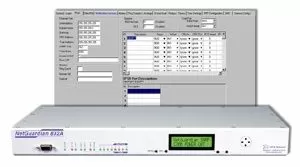How To Create and Restore Backups of Your NetGuardian 832A Configurations with NGEdit or FTP
The NetGuardian's feature selection can hold a large amount of configurable information, and if you lose that information because of error or failure it can be inconvenient to re-configure the whole thing manually. That's why DPS recommends NGEdit as the preferred provisioning interface for your NetGuardian 832As.
NetGuardian configurations can be backed up and restored quite easily- in several different ways, or from one NetGuardian to another. Exporting a configuration to a file allows you to transport, store, and backup a NetGuardian configuration, and what's more, do it completely independent of a NetGuardian unit or the NGEdit software.
This is very useful for quickly restoring your NetGuardian configurations in the event of unit failure or loss, updating several NetGuardian units to nearly identical settings, or archiving your database information.
By exporting the NetGuardian configuration file you can store them on a common network server. Then multiple technicians gain access to the master configuration files. They can also email individual unit configurations back and forth (instead of your entire NGEdit database).
Just follow these simple steps to start backing up your NetGuardian configurations with NGEdit and FTP.
Backing up and Restoring NetGuardian configurations from NGEdit.
Backing up
- Open NGEdit
- Open the desired configuration in NGEdit.
- Select "Device" from the menu bar.
- Select "Open Device."
- Select the desired configuration.
- Press the "Open" button.
- Export the NetGuardian configuration to a binary file.
- Select "Device" from the menu bar
- Select "Export to file"
- Select a desired location and file name to save the configuration.
- Press the "Save" button.
The NetGuardian binary configuration file can now be archived or transported.
Restoring
- Open NGEdit
- Start a new configuration
- Select "Device" from the menu bar.
- Select "New Device"
- Import the file.
- Select "Device" from the menu bar.
- Select "Import from file."
- Select the desired file.
- Press the "Open" button.
Note: This file must have a .bin file extension in order to be imported into NGEdit.
The NetGuardian configuration can now be viewed and edited with NGEdit.
Backing up and Restoring NetGuardian configurations via FTP.
Backup
- Ensure the NetGuardian has Ethernet connectivity.
Open a Windows Command Prompt
Press the "Start" button
Select "Run..."
Type 'command' in the "Open:" field
Press the "OK" button - Ping the unit
- Type 'ping 192.168.1.100' at the "C:\>" Windows command prompt. Note: Substitute 192.168.1.100 for the unit's IP address.
- Verify the unit returns the ping request. The screen should show a series messages, "Reply from 192.168.1.100: bytes=32 time=24ms TTL=60" Again, substitute 192.168.1.100 for the unit's IP address. If the unit ping request does not show valid responses, check with Network configuration as described in the NetGuardian Hardware manual available for download from the Support page on the DPS Telecom website.
- Get the NetGuardian configuration using an FTP get with a binary file transfer.
Press the start "Start" button on your PC.
Select "Run..."
Type "ftp 192.168.1.100" in the "Open:" field.
Press the "OK" button.
Press the <Enter> key at the User: Prompt
Enter the password of the NetGuardian (default password is 'dpstelecom') and hit <Enter>.
Type "binary" and hit <Enter> (necessary for NetGuardian file transfer).
Type "lcd" and hit <Enter> (this allows you to change the directory of your local machine. Note: This is where the FTP program will store the NetGuardian configuration file.)
Type "get" followed by the name you wish to define for the NetGuardian backup file. Add the extension "bin" to the filename (e.g. "get ngdbkup.bin) and hit <Enter>.
After backing up, type "bye" and hit <Enter> to exit.
Note: The backup file name can have a maximum of eight characters before the file extension.
Restore
- Ensure the NetGuardian has Ethernet connectivity.
Open a Windows Command Prompt
Press the "Start" button
Select "Run..."
Type 'command' in the "Open:" field
Press the "OK" button
Ping the unit
Type 'ping 192.168.1.100' at the "C:\>" Windows command prompt. Note: Substitute 192.168.1.100 for the unit's IP address.
Verify the unit returns the ping request. The screen should show a series messages, "Reply from 192.168.1.100: bytes=32 time=24ms TTL=60" Again, substitute 192.168.1.100 for the unit's IP address. If the unit ping request does not show valid responses, check the Network configuration as described in the NetGuardian Hardware manual. (Download the manual from my.dpstele.com - requires login or registration)
- Load the NetGuardian configuration to the unit using the FTP put command.
Press the start "Start" button on your PC.
Select "Run..."
Type "ftp 192.168.1.100" in the "Open:" field.
Press the "OK" button.
Press the <Enter> key at the User: Prompt
Enter the password of the NetGuardian (default password is 'dpstelecom') and hit <Enter>.
Type "binary" and hit <Enter> (necessary for NetGuardian file transfer).
Type "lcd" and hit <Enter> (this allows you to change the directory of your local machine. Note: This is where the FTP program will retrieve the NetGuardian configuration file.)
Type "put" followed by the name you defined for the NetGuardian backup file and hit <Enter> (e.g. "put ngdbkup.bin").
After reloading, type "bye" and hit <Enter> to exit.
Note: Configuration restorations should only be downloaded to units running the same firmware version as the original backup unit the configuration file came from.
If you want to protect your network against the dangers of service outages and equipment loss, check out the T/Mon LNX.

